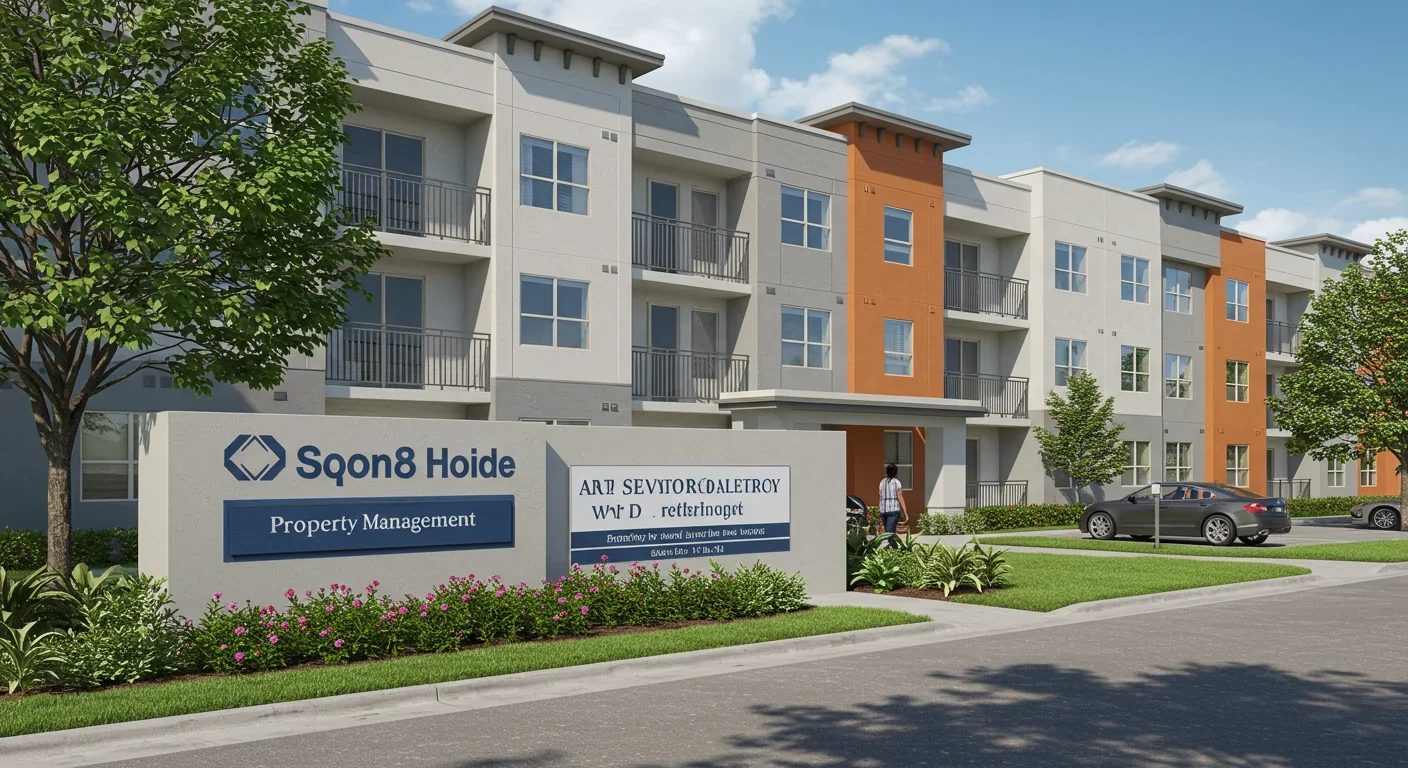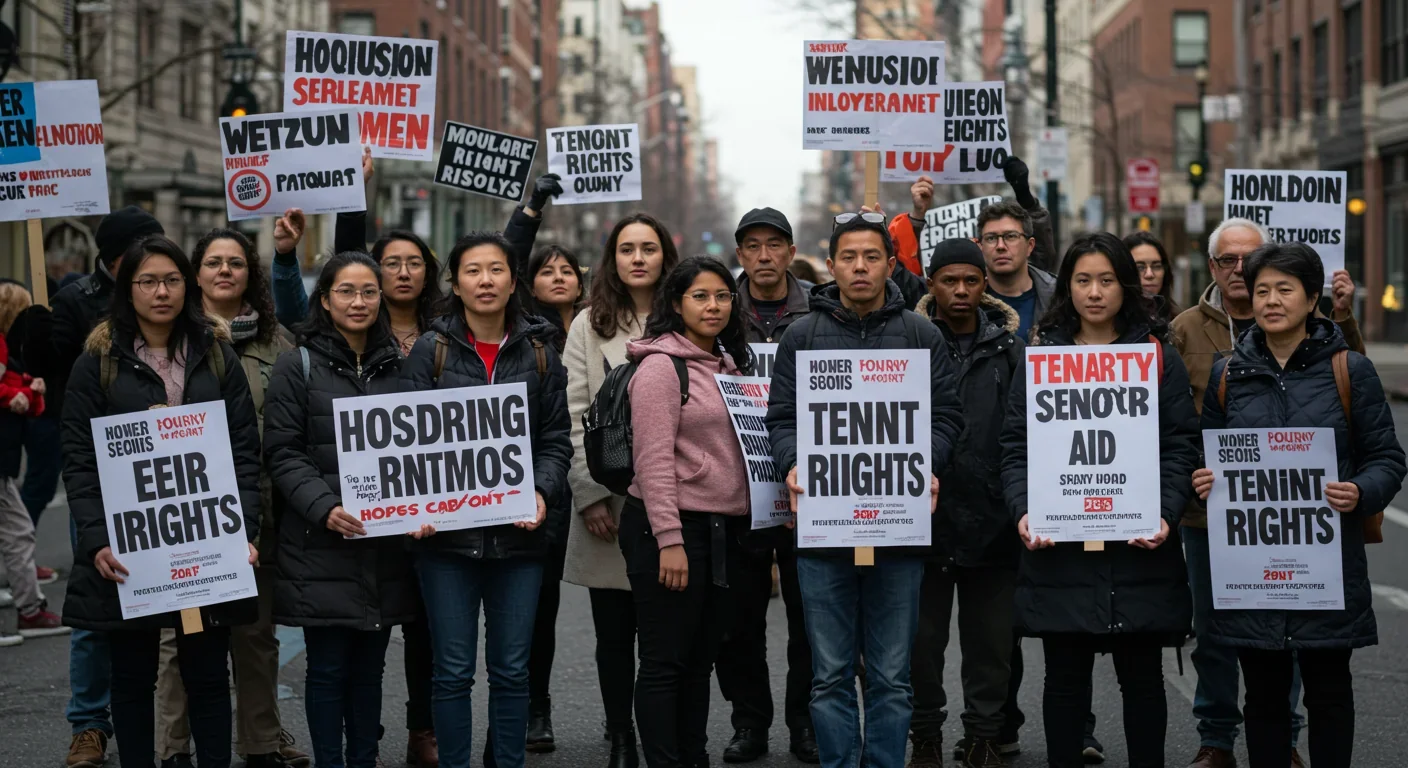Deinfluencing: Why Creators Tell Followers NOT to Buy

TL;DR: Renters pay mortgage-equivalent amounts but build zero wealth, creating a 40x wealth gap with homeowners. Institutional investors have transformed housing into a wealth extraction mechanism where working families transfer $720,000+ over 30 years while property owners accumulate equity and generational wealth.

Every month, you make a payment roughly equal to what a mortgage would cost. But unlike your homeowner friends who are building equity, your payment vanishes. Over thirty years, they'll own a $400,000 asset while you'll have nothing but receipts. This isn't just a personal failure to launch. It's how the system is designed to work.
The wealth gap between homeowners and renters has reached a historic extreme. According to recent federal data, the median homeowner is now nearly 40 times wealthier than the median renter. Homeowners hold a median net worth of $400,000, while renters scrape by with just $10,400. Half of that homeowner wealth comes from home equity alone, meaning renters are systematically excluded from the primary wealth-building mechanism available to ordinary Americans.
This disparity isn't shrinking. It's accelerating. The median wealth gap between these two groups surged from about $200,000 in the early 2000s to almost $390,000 by 2022. The average gap is even more staggering at over $1.37 million. While homeowners watched their net worth climb roughly 70% over the past three decades, renters remained financially stagnant, locked out of the asset appreciation that transforms monthly housing costs into long-term security.
Picture two 30-year-olds with identical $2,000 monthly housing payments. One buys a modest home with a mortgage. The other rents an equivalent apartment. Fast forward three decades. The homeowner now owns an asset worth hundreds of thousands of dollars and has been building equity with every payment. The renter has paid the same total amount but owns nothing.
The numbers tell a brutal story. Over 30 years of paying $2,000 monthly, the renter transfers $720,000 to landlords with zero ownership to show for it. The homeowner, paying the same amount, now holds an asset that likely appreciated well beyond the purchase price. That's not a minor difference in financial outcomes. It's a complete divergence in life trajectories.
But it gets worse. Renters aren't just paying equivalent amounts. They're actually paying more as a share of income. The median housing-cost-to-income ratio for renters increased by about 5 percentage points over the past 30 years, while the ratio for homeowners declined over the same period. Translation: housing got cheaper for owners and more expensive for renters.
About half of all renters are now "rent-burdened", spending more than 30% of their income on housing. Many spend far more. When you're dropping 40% or 50% of your paycheck on rent, saving for a down payment becomes mathematically impossible. The system traps you in place.
Something fundamental shifted in housing markets after the 2008 financial crisis. As foreclosed homes flooded the market, institutional investors swooped in to purchase thousands of properties at bargain prices. Companies like Blackstone, Invitation Homes, and American Homes 4 Rent accumulated massive portfolios of single-family rentals. They weren't buying homes to live in. They were acquiring income streams.
This represents the financialization of housing on an unprecedented scale. Residential real estate, once dominated by individual landlords and owner-occupants, increasingly functions as an asset class for global capital. Housing is no longer primarily shelter. It's a financial instrument designed to extract steady returns from tenants who have no other options.
The model is elegantly simple from an investor's perspective. Purchase properties, often ones deemed "undervalued" in lower-income neighborhoods. Perform minimal upgrades. Reposition them as higher-end rentals with professional property management. Extract maximum rent while minimizing maintenance costs. When you're managing 50,000 or 100,000 units, small efficiencies compound into billions in profit.
For renters, this shift changes everything. Corporate landlords are more likely to pursue evictions aggressively, less likely to negotiate with struggling tenants, and operate with algorithms optimized for revenue extraction rather than community relationships. You're not renting from Bob the landlord anymore. You're paying into a real estate investment trust that answers to shareholders demanding 7% annual returns.
The scale is stunning. By some estimates, residential real estate has become arguably the largest business in the world, valued at over $280 trillion globally, with $220 trillion of that in residential property alone. Working families are now competing against hedge funds with billions in capital and algorithms designed to identify undervalued markets.

Millennials and Gen Z face housing markets fundamentally different from those their parents navigated. When baby boomers turned 35, their homeownership rate was 61.5%. Gen X at the same age: 59%. Millennials at 35? Just 56%. Each generation is falling further behind.
The barriers are multiplying. Median home prices have surged while wages stagnated. Down payment requirements feel impossibly high when rent consumes half your income. Mortgage rates that were 2.66% in December 2020 hit 6.54% by October 2024, pricing countless buyers out of markets they could barely afford at lower rates.
Student loan debt adds another layer of impossibility. Previous generations could save for a down payment while paying modest rent. Today's young adults are juggling student loans averaging $30,000 to $100,000, rent that takes 35-50% of income, and trying to accumulate $40,000 to $80,000 for a down payment in markets where modest homes cost $350,000 to $500,000. The math simply doesn't work without family wealth.
That last point matters enormously. Intergenerational transfers are becoming the defining factor in who achieves homeownership and who remains locked in permanent rental status. If your parents own a home and accumulated equity, they can help with your down payment. If your parents rented their whole lives, you inherit nothing. The wealth gap compounds across generations, creating a new class structure based on housing tenure.
Research shows that less than half of renters own appreciating assets like stocks, compared to 78% of homeowners. Renters aren't just missing out on home equity. They're excluded from asset ownership entirely, lacking the capital base that makes investing in stocks or retirement accounts feasible. When every spare dollar goes to rent, building any form of wealth becomes impossible.
For decades, rent increases have systematically outpaced wage growth, creating a widening affordability crisis. Data shows that U.S. rents have grown faster than wages for the past five years, with rent rising nearly four times faster than income in some recent periods. This isn't a temporary blip. It's a structural mismatch between housing costs and earning power.
Consider what this means in practice. If your rent increases 5% annually but your wages grow 2%, you're falling behind every single year. Over a decade, that gap becomes catastrophic. The affordable apartment you moved into at $1,200 monthly now costs $1,950, but your salary hasn't kept pace. You're spending an ever-larger share of a paycheck that isn't growing fast enough.
Historical data reveals the long-term trajectory. Average rent in 1970 was $108. By 2020, it hit $1,104, a tenfold increase. Meanwhile, median household income only quintupled over the same period. Housing costs are consuming a steadily larger portion of American family budgets, leaving less for everything else.
The pandemic accelerated these trends. While temporary assistance programs briefly boosted renter net worth by 43% between 2019 and 2022, from $7,300 to $10,400, that modest gain couldn't overcome decades of structural inequality. As pandemic supports ended, renters returned to the same extractive dynamics, now facing even higher rents in increasingly competitive markets.
Supply shortages amplify the crisis. When housing construction fails to keep pace with population growth and household formation, landlords can raise rents with impunity. Renters have nowhere else to go. In tight markets, rent growth outpaces wage increases by significant margins, transferring wealth from working families to property owners at an accelerating rate.
Beyond the raw financial extraction, permanent rental status imposes psychological costs that don't appear in economic data. Housing insecurity creates chronic stress that affects health, relationships, and life planning. When you can't predict whether your rent will jump $300 next year or whether your landlord will sell the property, long-term planning becomes impossible.
Renters report feeling trapped in a cycle of instability. You hesitate to invest in your living space because it's not yours. You can't paint walls, upgrade fixtures, or make the place truly home. Lease renewals bring anxiety rather than security. Will the rent increase be manageable? Will the landlord decide to sell? Will new ownership mean displacement?
This insecurity affects everything. Career decisions, relationship commitments, whether to have children—all are complicated by housing instability. Homeowners can refinance to lower payments if times get tough. Renters have no such option. You're perpetually one rent increase away from having to move, find roommates, or relocate to a worse neighborhood.
The stress compounds when you watch homeowner friends build equity while you pay equivalent or higher amounts for nothing. They're locked into fixed mortgage payments while your rent climbs annually. Their housing costs decrease as a share of income over time. Yours increase. The psychological weight of that divergence is real, even if it's hard to quantify.

Other countries have found ways to prevent housing from becoming pure wealth extraction. Vienna's social housing model ensures that over 60% of residents live in publicly owned or subsidized housing with rents capped at affordable levels. Singapore's public housing program houses 80% of the population, with long-term leases that build equity even for non-owners.
These aren't utopian fantasies. They're functioning systems that recognize housing as infrastructure rather than investment vehicles. They demonstrate that alternatives exist to the American model of housing as financial instrument.
Rent control remains controversial, but jurisdictions with well-designed stabilization policies show it can work. The key is balancing tenant protection with incentives for maintenance and new construction. Berlin's rent cap experiment failed because it was too aggressive and drove investment away. But moderate rent stabilization in places like Oregon has protected tenants while maintaining housing supply.
Some cities are experimenting with community land trusts, where land is held collectively and homes sold at below-market rates with deed restrictions preventing speculation. Residents build equity but can't flip properties for maximum profit. It's a middle path between pure rental and pure ownership, designed to keep housing affordable across generations.
Rent-to-own programs offer another approach, allowing renters to convert monthly payments into eventual ownership. These programs have shown promise in cities like Cleveland and Baltimore, particularly for working families who can afford mortgage-equivalent payments but lack down payment capital. They transform extraction into accumulation.
At the federal level, proposals include substantial down payment assistance for first-time buyers, policies promoting savings in retirement accounts for renters, and rental assistance programs that prevent cost burdens from consuming entire paychecks. These represent band-aids on a systemic problem, but they'd provide immediate relief for millions.
So what can individual renters do within this rigged system? The frustrating answer is that personal solutions can't overcome structural problems, but some strategies help minimize extraction.
First, understand your true housing costs. That $1,800 rent isn't just $1,800. It's $1,800 plus renters insurance, plus utilities that you can't control through efficiency improvements, plus the opportunity cost of not building equity. Calculate what you're actually paying annually and compare it honestly to homeownership costs in your market, including property taxes, insurance, maintenance, and mortgage interest.
Second, negotiate ruthlessly. Landlords hate turnover because it's expensive. If you're a reliable tenant, you have leverage at lease renewal time. Research comparable rents in your area and make a case for smaller increases. Many landlords will accept below-market increases to keep good tenants.
Third, consider house hacking strategies if homeownership is even remotely feasible. Buy a duplex or multi-unit property, live in one unit, rent the others. Your renters pay your mortgage while you build equity. It requires capital and risk tolerance, but it's one of the few ways to flip the script from extracted to extractor.
Fourth, invest aggressively in whatever assets you can access. If homeownership is impossible, max out retirement accounts, invest in index funds, build emergency savings. Renters who also own stocks and retirement assets narrow the wealth gap significantly compared to renters with no investments at all. You won't match homeowner wealth accumulation, but you'll avoid complete financial stagnation.
Fifth, relocate strategically if possible. Some markets have far better rent-to-income ratios than others. The Midwest and South often offer better affordability than coastal cities. Remote work has made geographic arbitrage more feasible for many workers. You might not escape the rental trap entirely, but you can minimize the extraction rate.
Finally, organize politically. The system won't change without policy intervention, and policy won't change without political pressure. Join tenant unions, support pro-housing candidates, advocate for zoning reforms that increase supply, push for social housing programs. Individual action is limited. Collective action can reshape markets.
The current trajectory is unsustainable. As the homeowner-renter wealth gap widens and homeownership becomes increasingly concentrated among those who inherited wealth, we're creating a new feudal structure. Property owners extract rents from a permanent tenant class with no path to ownership.
This threatens social cohesion and economic dynamism. When young adults can't afford homes, they delay marriage, postpone children, and reduce consumption beyond necessities. When working families spend 40-50% of income on rent, they can't save, invest, or take entrepreneurial risks. The economy stagnates.
Some economists argue the crisis will self-correct as high prices incentivize construction and supply eventually matches demand. But decades of evidence suggest otherwise. Zoning restrictions, NIMBY politics, and construction costs prevent supply from adjusting quickly enough. Meanwhile, financialization accelerates as more institutional capital floods into residential real estate seeking steady returns.
Others suggest we should embrace a rental society, pointing to Germany and Switzerland where renting is common even among middle-class families. But those countries have strong tenant protections, rent control, and social housing systems that prevent pure extraction. Simply normalizing permanent rental status without systemic reforms means normalizing wealth transfer from workers to property owners.
The most likely outcome is continued divergence. Those with family wealth and access to homeownership will accumulate assets and pass them to children. Those trapped in rental markets will remain financially stagnant, unable to build wealth or provide inheritance. We're creating hereditary economic classes based on housing tenure, a return to aristocracy by another name.
Breaking this cycle requires recognizing housing as infrastructure, not investment. It means building social housing at scale, implementing sophisticated rent regulations that balance tenant protection with supply incentives, ending exclusionary zoning that restricts density, and taxing land value to discourage speculation. These aren't radical proposals. They're standard policies in other developed nations.
The renting trap isn't an accident or a temporary market failure. It's the predictable outcome of treating housing as a financial asset while failing to provide alternatives for those priced out of ownership. Every month, millions of Americans transfer wealth to property owners while building nothing for themselves. That's not capitalism working efficiently. It's extraction masquerading as a housing market.
You can make individual choices to minimize the damage, but you can't optimize your way out of systemic inequality. The gap between homeowner and renter wealth won't close through better budgeting or financial literacy. It will close when we decide that housing is infrastructure essential to economic participation, not an investment vehicle for wealth accumulation.
Until then, the trap remains set. Every month, your rent payment enriches someone else while your net worth stays frozen. The math is brutal, the psychology is exhausting, and the intergenerational consequences are dire. The question isn't whether the system extracts wealth from renters. The question is whether we'll build something different.

Curiosity rover detects mysterious methane spikes on Mars that vanish within hours, defying atmospheric models. Scientists debate whether the source is hidden microbial life or geological processes, while new research reveals UV-activated dust rapidly destroys the gas.

CMA is a selective cellular cleanup system that targets damaged proteins for degradation. As we age, CMA declines—leading to toxic protein accumulation and neurodegeneration. Scientists are developing therapies to restore CMA function and potentially prevent brain diseases.

Intercropping boosts farm yields by 20-50% by growing multiple crops together, using complementary resource use, nitrogen fixation, and pest suppression to build resilience against climate shocks while reducing costs.

The Baader-Meinhof phenomenon explains why newly learned information suddenly seems everywhere. This frequency illusion results from selective attention and confirmation bias—adaptive evolutionary mechanisms now amplified by social media algorithms.

Plants and soil microbes form powerful partnerships that can clean contaminated soil at a fraction of traditional costs. These phytoremediation networks use biological processes to extract, degrade, or stabilize toxic pollutants, offering a sustainable alternative to excavation for brownfields and agricultural land.

Renters pay mortgage-equivalent amounts but build zero wealth, creating a 40x wealth gap with homeowners. Institutional investors have transformed housing into a wealth extraction mechanism where working families transfer $720,000+ over 30 years while property owners accumulate equity and generational wealth.

AlphaGo revolutionized AI by defeating world champion Lee Sedol through reinforcement learning and neural networks. Its successor, AlphaGo Zero, learned purely through self-play, discovering strategies superior to millennia of human knowledge—opening new frontiers in AI applications across healthcare, robotics, and optimization.